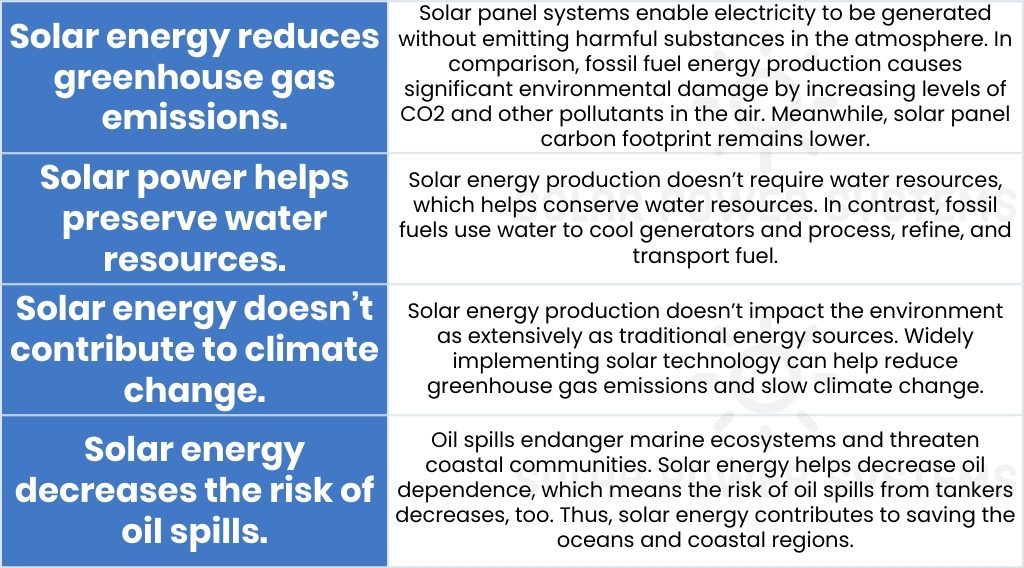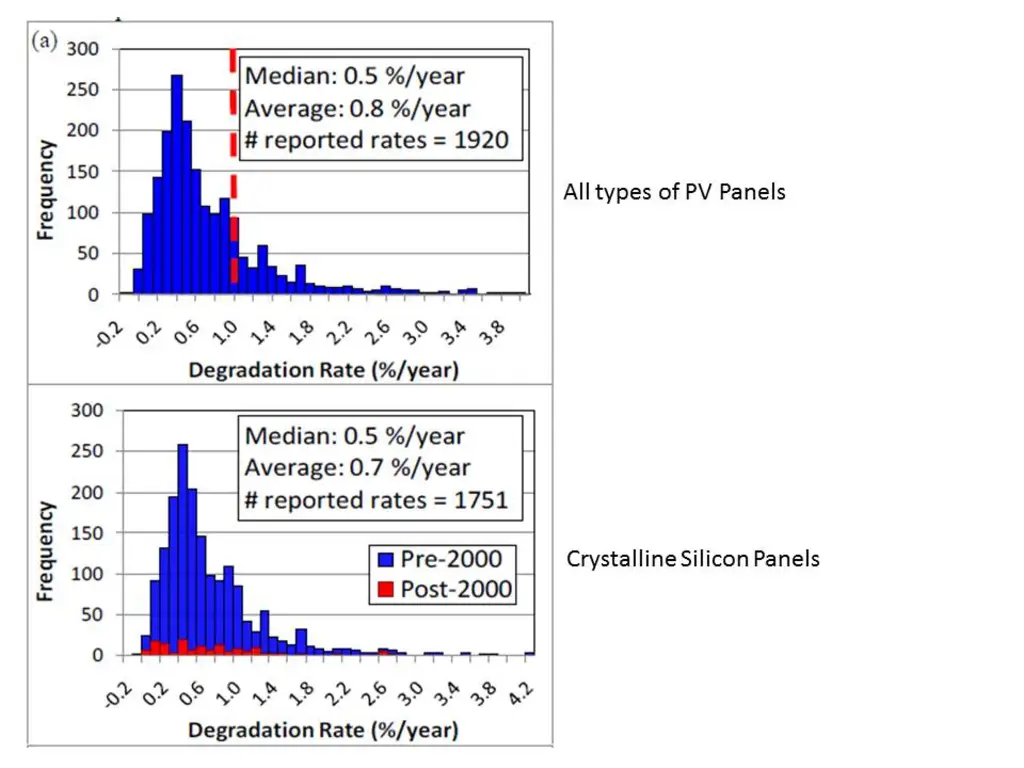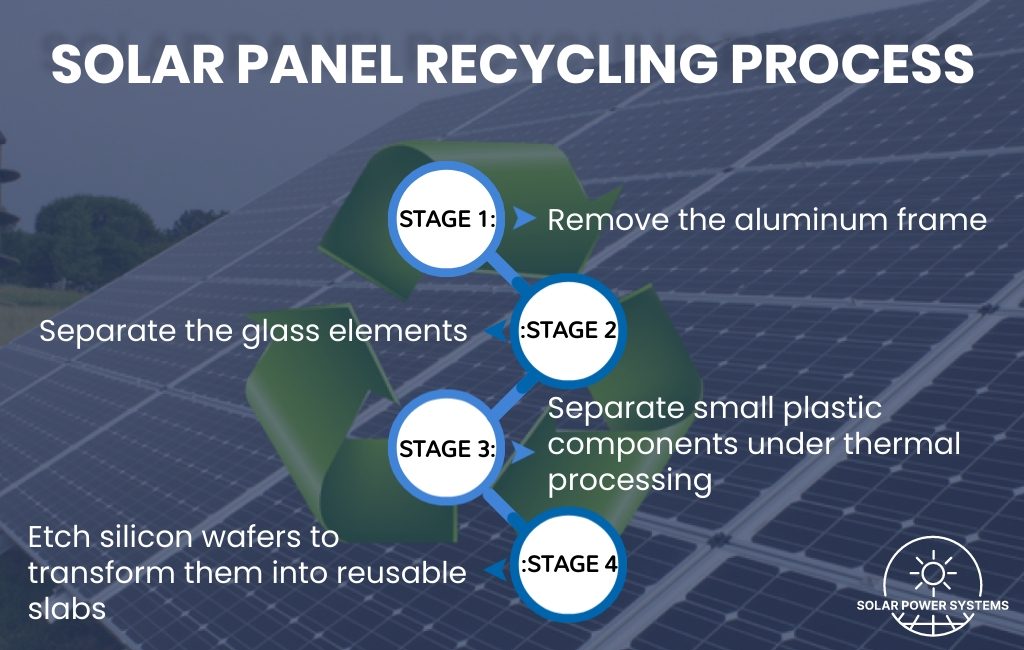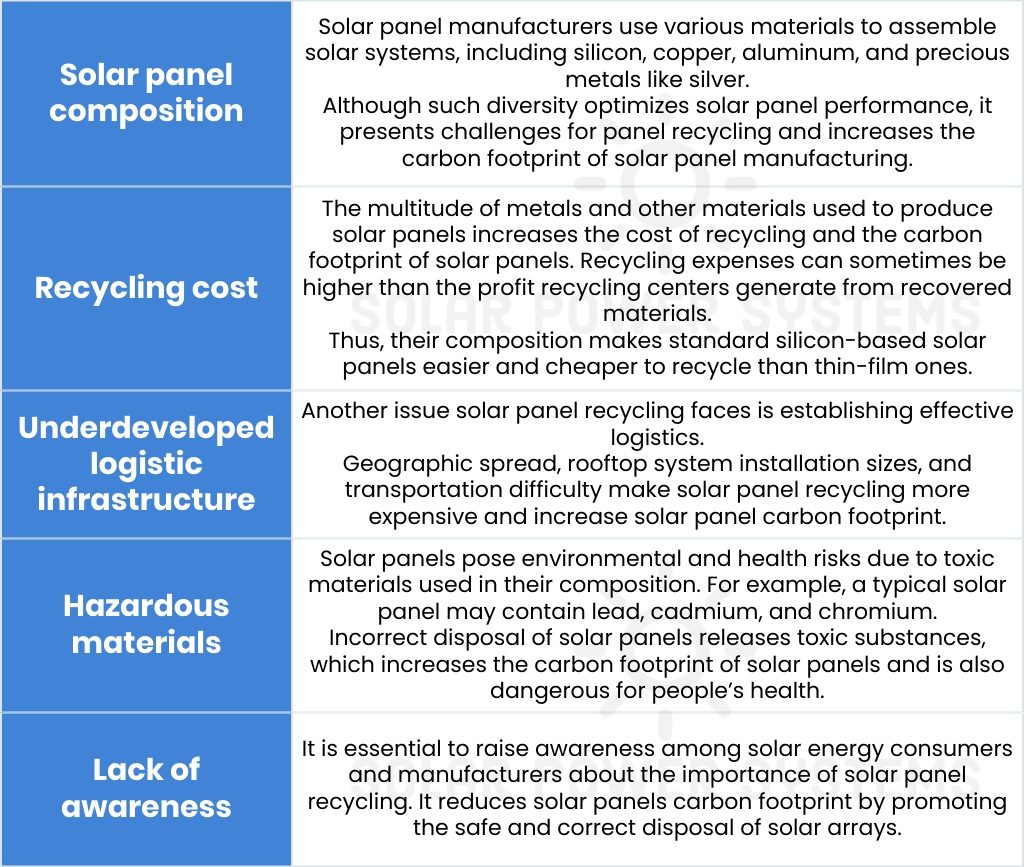Solar energy enthusiasts are familiar with the numerous practical benefits of equipping their rooftops with solar panels. Solar-generated electricity helps reduce monthly bills and provides an alternative power source even during a power outage. In addition, it increases property value in the long run.
However, despite financial gain, many homeowners equip their houses with solar array systems to implement environmentally friendly energy solutions. Yet, are solar panels truly as beneficial as advertised? How big is the carbon footprint of solar panels? Let’s dissect solar panel carbon footprint and solar emissions associated with panel production.
The Environmental Benefits of Solar Panels
Solar energy adoption allows us to achieve much-needed energy independence and present environmental benefits. Do solar panels reduce carbon footprint? Though solar panel manufacturing is not emission-free, and many experts question the “green” nature of solar technology, solar panels’ positive environmental impact is undeniable.

Are Solar Panels Carbon Neutral?
Even though the carbon footprint of solar panels is not as high as that of fossil fuel-based energy, it is still not neutral. Compared to hydro, onshore wind turbines, and nuclear energy sources, rooftop systems’ solar panel carbon footprint is noticeable.
The Intergovernmental Panel on Climate Change research reveals insights:
- Solar panels are responsible for carbon dioxide emissions, the equivalent of about 40g/kWh of electricity they produce.
- Mining raw materials and the solar panel manufacturing process comprise around 70% of solar emissions.
- Solar panel operation and recycling account for the remaining 30%.
Various factors influence how much solar panel systems damage the environment and how high the solar panel footprint is. Let’s break down some of them.
What Is the Carbon Footprint of Solar Panels?
Solar energy undoubtedly leaves a carbon footprint. However, solar panels have a much lower carbon footprint compared to fossil fuel energy production, being 20 times lower than coal-based energy generation.
The question of the “hidden” solar panel carbon footprint remains controversial.
- Crystalline silicon solar panel systems generate a higher carbon footprint of around 40g/kWh of energy due to the energy-intensive silicon manufacturing process.
- The solar panel footprint in thin-film modules is lower. It ranges between 12 and 24 gr/kWh, depending on how new the system is.
What Influences the Solar Panel Carbon Footprint?
Some experts accuse the solar energy industry of concealing solar panels’ hidden carbon footprint. Though some believe solar energy’s green nature is in question, we must understand that solar panel manufacturing should involve some solar emissions.
Unlike traditional energy sources, solar panels don’t release pollutants while generating energy, making them an irreplaceable component of the clean energy transition. However, unavoidable emissions are still released during solar panel manufacturing. Let’s discuss what factors influence the carbon footprint of solar panel manufacturing.
Solar Panel Type
One of the factors determining the carbon footprint of solar panels is the panel type. Three types of solar panels exist: monocrystalline, polycrystalline (PV), and thin-film. Each type carries distinct CO2 emission levels.

Mining Materials Safety
Solar energy adoption helps decrease CO2 emissions in the atmosphere. That’s why the carbon footprint of solar panels is lower compared to fossil fuel-based energy. However, we tend to overlook solar panel manufacturing pollution caused by mining materials used in different types of solar panels. Monocrystalline, polycrystalline, or even thin-film solar panels still contain silicon cells.
Silicon cells are semiconductors that convert sunlight into electricity. This current travels through the conductive metal grid lines of a solar system. Silicon cells use substances that reduce reflection and improve absorption qualities. In such a way, they maximize the electricity generation potential of solar panels.
Unfortunately, silicon belongs to rare metals mining, which contributes to increased greenhouse gas emission levels. In addition, the silicon mining process contaminates air, water, and soil resources. However, we see companies implementing more eco-friendly technologies, such as using recycled materials to mitigate the harmful effects of silicon mining.
Solar Panel Lifespan
Another factor influencing the carbon footprint of solar panels is their lifespan. Under typical circumstances, solar panel systems last between 25 and 30 years. However, solar panel owners benefit financially from solar system installation much sooner. Depending on your location and the solar incentives, you can repay so-called carbon debt after around three years of usage.

Source: Engeneering.com
While solar panel systems get older, their efficiency starts to decline gradually. On average, solar panels lose around 0,5% of their yearly efficiency. However, due to various incentive programs, many homeowners replace their solar panel systems much sooner than they end their productive lives. This results in an increased solar panel carbon footprint from discarded solar panels.
Assessing the Carbon Footprint of Solar Panel Manufacturing
One of the factors contributing to solar panel carbon footprint is the process of manufacturing solar modules. To comprehend the origins of pollutants, let’s explore the production stages of solar panels briefly.
Stage 1. Mining Raw Materials
Solar panel manufacturing starts with mining raw materials, mainly silicon, which is expensive but widely available. Solar panel manufacturers obtain high-purity silicon from quartz sand in furnaces at very high temperatures. The energy intensity of the process increases the carbon footprint of solar panels.
Stage 2: Melting Silicon Into Ingots
Collected silicon undergoes melting under high temperatures to form ingots. It also aligns atoms in the desired orientation. Then, the silicon gets positive electrical polarity through adding boron.
Stage 3. Wafers Production
The next step of solar panel manufacturing is slicing ingots into wafers using a wire saw. This process creates paper-thin wafers that reflect sunlight. The final step of wafer production is applying an anti-reflective coating to maximize solar module efficiency.
Stage 4: Converting Wafers Into Solar Cells
This stage involves adding metal conductors to the wafer surface. They enable the conversion of solar energy into electricity. Next, a thin layer of phosphorous is diffused over the surface of the wafers. Boron and phosphorous combined give a positive-negative junction, ensuring the proper functioning of PV modules.
These four stages consume a lot of energy resources and imply working with potentially toxic substances that can increase the carbon footprint of solar panels.
Step 5: Assembling Solar Panels
Solar panels contain solar cells integrated into a single structure with the help of metal connectors. Glass covers the front side of a panel, and a back sheet consists of durable polymer material. A junction box enables connections inside solar modules. The last step is adding a frame that protects solar panels against unfavorable weather conditions and allows them to be mounted.
The various materials used to make PV modules complicate solar panel recycling and contribute to higher solar panel carbon footprint levels.
Can Recycling Reduce the Carbon Footprint of Solar Panels?
Despite the difficulties of the recycling process, it is possible. But does solar panel recycling decrease solar panel carbon footprint? The answer is nuanced. Let’s concentrate first on how solar panels are recycled and what hidden environmental hazards the process has.

The type of solar panel doesn’t define how much material you can extract during recycling.
- All typical crystalline panels contain silicon, glass, aluminum, polymer, and copper. Reusing these elements helps decrease solar emissions by 42%.
Though solar energy transition benefits local economies and has numerous environmental benefits, they are problematic to dispose of at the end of their lifespan. Unfortunately, collection infrastructure and recycling centers are still underdeveloped in many areas. As a result, long transportation leads to a higher solar panel carbon footprint.
Here are some common challenges the solar panel recycling industry faces.

Recent Improvements in Solar Panel Manufacturing
The solar industry implements many improvements and innovations to improve solar panel efficiency, prolong its lifespan, and reduce solar panel carbon footprint. Let’s review some of the most prominent ones.

Solar Panel Efficiency Improvement
The solar industry continues to focus on PV panels’ efficiency. Innovative materials and designs open new possibilities for converting sunlight into energy. These steps make solar panels more cost-effective and reduce solar panel carbon footprint in the long term.
Bifacial Solar Panels Introduction
At the core of bifacial solar panels is the idea of capturing sunlight from both sides. This allows for increased energy production and decreased solar panel installation costs. The more productive solar panels are, the lower the solar panel carbon footprint is.

Improved Solar Energy Storage Options
Developing lithium-ion and solid-state batteries is a massive step towards making solar systems more reliable. It enables a consistent energy supply, even during rainy and cloud periods. Improved reliability results in longer solar panel system lifespans and reduces the carbon footprint of solar panels over time.
The Growth of Smart Solar System Usage
We observe a growing trend in integrating innovative technology with solar panel systems, such as artificial intelligence. AI tools enable real-time monitoring of solar energy production and optimize the effectiveness of solar systems. Increased electricity generation helps reduce the solar footprint.
Is Solar Energy Green After All?
Solar energy is not emission-free. However, the carbon footprint of solar panels is significantly lower than that of energy powered by traditional fossil-fuel sources. Solar-associated pollution often results from the solar panel manufacturing process, the mining of materials used for PV modules, and improper recycling methods.
The outlook for solar panel technology is optimistic. Improved recycling techniques and the introduction of various innovations in the solar energy field can potentially decrease the solar panel footprint and improve PV systems’ efficiency.
Frequently Asked Questions
Does solar energy produce carbon dioxide?
Yes, solar energy modules produce around 50g/kWh of CO2 during the first years of usage. It is 20 times less than the carbon footprint of traditional energy sources.
How long does it take for a solar panel to become carbon neutral?
On average, solar panels become carbon neutral by the third year of their operation. The time needed depends on the quality and efficiency of the system.
Are solar panels hazardous waste?
Solar panel waste toxicity depends on its composition. Some metals in solar modules, such as lead and cadmium, can harm the environment.
Where does solar panel manufacturing pollution come from?
The most significant danger of solar panel manufacturing is the usage of toxic metals as PV components. In addition, exposure to silicon and copper dust can harm solar manufacturing workers’ health.


